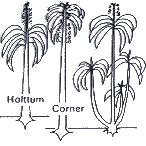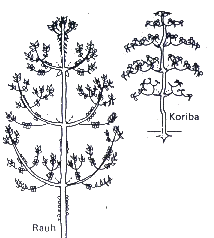| Overview | ||||
| Corner and the durian theory | ||||
| Ashton, Fedorov and evolutionary processes | ||||
| Gentry's hypotheses | ||||
Applications
|
||||
| References and further reading | ||||
| Questions |
Examples of such models show the increasing complexity of growth form from the ancestral angiosperm used by Corner to develop his Durian theory, to the taxonomically higher order families with complex branching patterns, arrangements of flowers and a reduction in the size of vegetative and reproductive structures.


Using the patterns of distribution of models within and between families, relationships in architecture can be seen both pan tropically and between the palaeo- and neotropics. Correlations are also evident with environmental factors such as altitude, water and light conditions.
Applications of this approach occur across a range of disciplines within tropical biology, such as economic botany, physiology and soil science. Use of such a radically different view of plant diversity allows evolutionary hypotheses to be developed outside the constraints of classical temperate plant systematics.
NOW TEST your understanding of the basic principles by answering some questions.